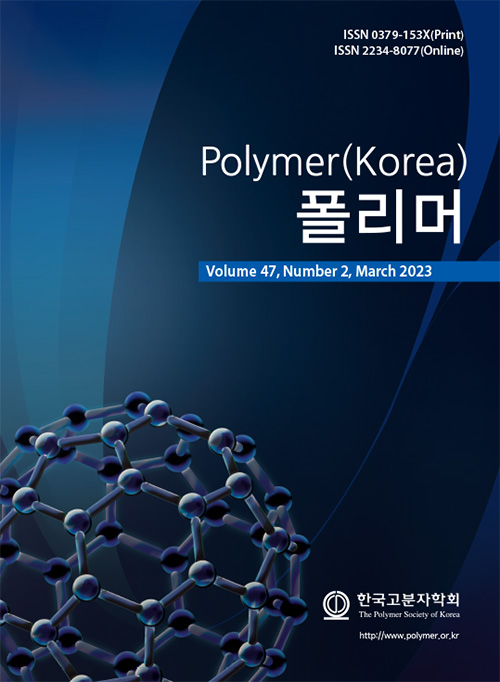- Electrochemical Glucose Sensing by Using Glucose Dehydrogenase Enzyme and the Synthesized Poly-ruthenium Mediator
Department of Chemistry, College of Science & Technology, Dankook University, Dandae-ro, Cheonan-si, Chungnam 31116, Korea
*School of Chemical Engineering, Translational Nanobioscience Research Center,
and Biomedical Institute for Convergence at SKKU (BICS), Sungkyunkwan University, Suwon 16419, Korea- 포도당 탈수소효소와 합성된 폴리루테늄 매개체를 이용한 전기화학적 포도당 감지
단국대학교 화학과
*성균관대학교 화학공학과, 트랜스레이셔널 나노바이오사이언스 연구센터, 성균바이오융합과학기술원Reproduction, stored in a retrieval system, or transmitted in any form of any part of this publication is permitted only by written permission from the Polymer Society of Korea.
Diabetes necessitates the use of reliable glucose sensors capable of preventing the onset of complications via accurate and timely diagnosis. Among such sensors is a second-generation glucose amperometric sensor that uses an electrochemical method and is based on a mediator that transfers electrons from the enzyme to the electrode. Group VIII metals, such as iron, ruthenium, and osmium, have conventionally been used, and are synthesized with both electron-withdrawing and -donating ligands. Among these mediators, hexaamineruthenium(III) transferred electrons generated by glucose via glucose oxidase (GOx) to the electrode, allowing glucose quantification. However, a measurement error of the GOx enzyme was recently discovered due to external oxygen interference; therefore, it is being replaced with the enzyme glucose dehydrogenase (GDH). Hexaamineruthenium(III) exhibited a low electron transfer efficiency due to electrons stolen during the reaction with the GDH enzyme. Thus, to solve this problem, herein we synthesized a polymer-based ruthenium mediator complex, viz. polyvinylimidazole-[ruthenium(4,4'-diamino-2,2'-bipyridine)2chloride] (PVI-[Ru(dam-bpy)2Cl]) for electrochemical glucose sensing. The structure of the new mediator was determined using 1H nuclear magnetic resonance, Fourier-transform infrared, and ultraviolet-visible spectroscopies. Furthermore, electrochemical properties were determined using cyclic voltammetry and a multi-potential step. PVI-[Ru(dam-bpy)2Cl] interacted favorably with GDH. Finally, electrochemical linearity was demonstrated with a wide range of glucose concentrations (1-40 mM). We anticipate that PVI-[Ru(dam-bpy)2Cl] can be used directly in the industry as a second-generation glucose biosensor.
당뇨병의 정확한 진단을 위해 산업체에서는 2세대 포도당센서를 사용해왔다. 2세대 포도당센서의 전자전달 매개체는 철, 루테늄 및 오스뮴과 같은 VIII족 금속으로 이루어져 있으며 본 논문에서는 포도당 탈수소 효소(GDH) 와 감응하는 새로운 전자전달 매개체를 합성하였다. 전기화학적 포도당 센서용 polyvinylimidazole(PVI)-[루테늄(4,4'-diamino-2,2'-bipyridine)2Cl](PVI-[Ru(dam-bpy)2Cl]) 전자전달 매개체의 구조는 1H nuclear magnetic resonance, Fourier-transform infrared 및 ultraviolet-visible spectroscopy로 측정하였다. 또한, cyclic voltammetry와 multi-potential step을 사용하여 전기화학적 특성을 분석하였다. PVI-[Ru(dam-bpy)2Cl]은 GDH를 사용하여 전극을 제작하였고, 마지막으로, 광범위한 포도당 농도(1-40 mM)에서 전기화학적 선형성이 입증되었다. PVI-[Ru(dam-bpy)2Cl] 전자전달 매개체가 2세대 포도당 바이오센서로서 산업계에서 직접 사용될 수 있을 것으로 기대한다.
Keywords: glucose sensor, polymer mediator, glucose dehydrogenase, second generation, electrochemistry.
- Polymer(Korea) 폴리머
- Frequency : Bimonthly(odd)
ISSN 0379-153X(Print)
ISSN 2234-8077(Online)
Abbr. Polym. Korea - 2023 Impact Factor : 0.4
- Indexed in SCIE
 This Article
This Article
-
2023; 47(2): 171-180
Published online Mar 25, 2023
- 10.7317/pk.2023.47.2.171
- Received on Nov 10, 2022
- Revised on Jan 16, 2023
- Accepted on Jan 31, 2023
 Correspondence to
Correspondence to
- Young-Bong Choi
-
Department of Chemistry, College of Science & Technology, Dankook University, Dandae-ro, Cheonan-si, Chungnam 31116, Korea
- E-mail: chem0404@dankook.ac.kr










 Copyright(c) The Polymer Society of Korea. All right reserved.
Copyright(c) The Polymer Society of Korea. All right reserved.